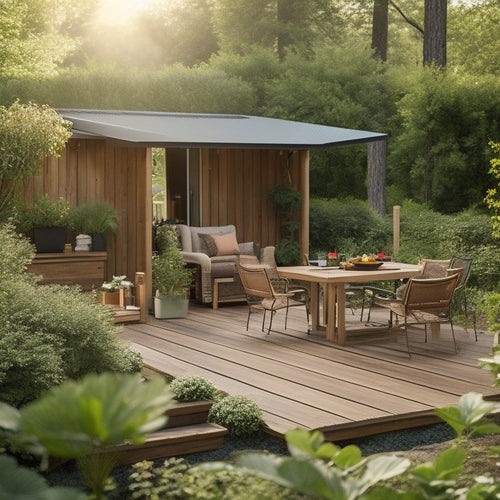
7 Best Eco-Friendly HVAC Upgrades for Your Home
Share
You're investing in a more sustainable future by exploring eco-friendly HVAC upgrades for your home, and with the right improvements, you can markedly reduce your carbon footprint and energy bills. Consider upgrading to a smart thermostat, which learns your daily routine to optimize energy usage. High-efficiency furnace replacements, eco-friendly air conditioning units, and heat pump systems can also make a substantial impact. Additionally, duct sealing and insulation upgrades, energy recovery ventilation systems, and radiant barrier installation can further reduce energy consumption. By implementing these upgrades, you'll not only reduce your environmental impact but also uncover additional opportunities to enhance your home's sustainability.
Key Takeaways
- Smart thermostats optimize energy usage, learn daily routines, and integrate with solar solutions for maximum eco-friendliness.
- High-efficiency heating and cooling systems reduce energy consumption, lower emissions, and improve performance.
- Duct sealing and insulation upgrades prevent energy loss, reduce costs, and enhance system efficiency and comfort.
- Energy Recovery Ventilation (ERV) systems improve indoor air quality, recover energy, and reduce ventilation loads.
- Radiant barrier installation reduces energy bills, reflects heat, and prolongs HVAC lifespan, leading to environmental benefits.
Smart Thermostats for Energy Efficiency
With the increasing focus on eco-friendly HVAC upgrades, investing in a smart thermostat can be an essential step towards energy efficiency. You'll have more control over your home's temperature, allowing you to optimize energy usage and reduce waste.
Importantly, integrating solar-powered charging solutions fast charging infrastructure can also contribute to a more sustainable home.
Smart thermostats offer advanced features like smart scheduling, which learns your daily routine to adjust temperatures accordingly. This means you can save energy when you're not home or when you're sleeping.
Additionally, remote access allows you to adjust the temperature from your phone or tablet, giving you the freedom to make changes on-the-go.
High-Efficiency Furnace Replacement
When you replace your old furnace with a high-efficiency model, you can expect significant energy savings potential.
By doing so, you'll not only reduce your energy consumption but also lower your carbon footprint, guaranteeing lower emissions.
With a high-efficiency furnace, you'll be able to heat your home more effectively while minimizing your environmental impact.
Energy Savings Potential
Replacing an old furnace with a high-efficiency model can greatly cut your energy consumption, leading to substantial cost savings.
This upgrade can markedly reduce your reliance on non-renewable energy sources, aligning with your values of freedom and sustainability. By moving towards renewable energy sources, like solar and wind power, you can combat climate change and contribute to a more sustainable future.
Additionally, investing in renewable energy can lead to considerable reductions in greenhouse gas emissions, making it an essential step towards a cleaner environment.
You can expect the following energy savings benefits:
- Up to 40% reduction in energy consumption, resulting in lower utility bills.
- Increased energy efficiency, as high-efficiency furnaces convert more energy into heat.
- Improved performance, with enhanced airflow and temperature control.
- Long-term savings, as high-efficiency furnaces often last longer than traditional models.
Lower Emissions Guarantee
By opting for a high-efficiency furnace replacement, you'll lock in a lower emissions guarantee, considerably mitigating your carbon footprint.
This upgrade guarantees that your heating system operates at peak performance while minimizing its environmental impact. High-efficiency furnaces are designed with sustainable materials and advanced technology, allowing them to convert a higher percentage of fuel into usable heat.
Additionally, integrating renewable energy sources like solar-powered fast charging and wind power can further reduce greenhouse gas emissions. As a result, you'll reduce the amount of greenhouse gases emitted into the atmosphere, contributing to a cleaner environment.
With a lower emissions guarantee, you can enjoy the freedom to live comfortably while knowing you're doing your part to reduce your carbon footprint.
Eco-Friendly Air Conditioning Units
You're looking to upgrade your air conditioning unit to a more eco-friendly option.
High-efficiency AC systems can considerably reduce energy consumption, and you'll want to investigate options that use environmentally friendly refrigerants.
By choosing the right AC unit, you can minimize your carbon footprint and lower your energy bills.
Implementing sustainable fuel options like electrification and examining alternative fuel sources can also contribute to a greener fleet and home.
High-Efficiency AC Systems
Upgrading to high-efficiency AC systems is an essential step towards reducing your carbon footprint and slashing energy bills.
These systems are designed with energy efficient designs and sustainable materials, ensuring a minimized impact on the environment.
Additionally, understanding the benefits of electric cars, such as their zero emissions, can inspire homeowners to adopt similar eco-friendly solutions for their homes.
When selecting a high-efficiency AC system, consider the following key features:
- SEER Rating: Look for a system with a high Seasonal Energy Efficiency Ratio (SEER) rating, which measures its energy efficiency.
- Compressor Technology: Opt for a system with a high-efficiency compressor that reduces energy consumption.
- Airflow Optimization: Choose a system with advanced airflow optimization features to improve cooling performance.
- Smart Thermostats: Consider a system with smart thermostat integration to optimize energy usage and comfort.
Eco-Friendly Refrigerant Options
When shopping for an eco-friendly AC system, you'll want to pay attention to the refrigerant used, as it can have a significant impact on the environment.
Traditional refrigerants, such as chlorofluorocarbons (CFCs) and hydrochlorofluorocarbons (HCFCs), contribute to ozone depletion and climate change. Instead, look for systems that use natural refrigerants like carbon dioxide, hydrocarbons, or ammonia, which have negligible environmental impact.
Refrigerant regulations, like the Montreal Protocol, phase out harmful substances and promote eco-friendly alternatives. Verify your chosen AC system complies with these regulations and considers the entire lifecycle of the refrigerant, from production to disposal.
Radiant Barrier Installation Benefits
Efficiency converges with innovation in radiant barrier installation, as this eco-friendly HVAC upgrade optimizes your attic's thermal performance.
By reducing heat gain in the summer and heat loss in the winter, you'll enjoy a more comfortable living space while minimizing your energy consumption. The installation cost may vary depending on the size of your attic and the type of radiant barrier material used.
However, the benefits far outweigh the investment. Here are some advantages of radiant barrier installation:
- Reduced energy bills: Lower energy consumption translates to lower utility bills.
- Increased radiant barrier effectiveness: Reflective materials can reduce heat gain by up to 97%.
- Extended HVAC system lifespan: By reducing the load on your HVAC system, you can extend its lifespan.
- Environmental benefits: By reducing energy consumption, you'll also reduce your carbon footprint.
Heat Pump Systems for Homes
As you optimize your attic's thermal performance with radiant barrier installation, it's time to contemplate another eco-friendly HVAC upgrade that can further reduce your energy consumption and environmental impact: heat pump systems for homes.
These systems utilize geothermal heat, a naturally occurring energy source, to provide efficient heating and cooling. You can choose from various types, including ductless systems, which eliminate the need for ductwork, reducing energy loss and increasing flexibility.
Duct Sealing and Insulation Upgrades
Frequently, homeowners overlook a crucial aspect of their HVAC system: the ducts.
However, neglecting duct maintenance can lead to energy loss, increased energy bills, and reduced system efficiency. To avoid this, you should prioritize duct sealing and insulation upgrades.
Here are some essential duct maintenance tips and insulation material options to evaluate:
-
Seal duct leaks: Use mastic sealant or foil tape to seal gaps and cracks in your ducts.
-
Choose the right insulation material: Select from options like fiberglass, cellulose, or spray foam insulation, each with its own R-value and installation requirements.
-
Insulate accessible ducts: Focus on ducts in unconditioned spaces like attics, crawlspaces, or garages.
- Evaluate professional duct inspection: Hire a professional to inspect and seal your ducts if you're not comfortable with the process.
Energy Recovery Ventilation Systems
Your home's air quality can greatly benefit from a well-designed ventilation system.
Energy Recovery Ventilation (ERV) systems are a great way to improve indoor air quality while minimizing energy losses.
ERV systems work by transferring heat and moisture from outgoing stale air to incoming fresh air, recovering up to 80% of the energy that would otherwise be lost.
This results in significant ventilation efficiency, reducing the load on your heating and cooling system.
By installing an ERV system, you'll not only breathe easier but also save energy and money.
With an ERV system, you can enjoy a healthier, more comfortable living space while minimizing your environmental footprint.
Frequently Asked Questions
Can I Install Eco-Friendly HVAC Upgrades Myself or Do I Need a Professional?
You're not a skilled chef, so don't try to whip up a DIY HVAC upgrade; it's a recipe for disaster. Instead, hire a professional installation expert to guarantee a smooth, efficient, and safe changeover to eco-friendly heating and cooling.
How Long Does It Take to Recoup the Cost of HVAC Upgrades Through Energy Savings?
You'll recoup the cost of HVAC upgrades through energy savings on a timeline dependent on factors like system efficiency, usage, and local energy prices; a thorough cost-benefit analysis will help you determine the exact payback period.
Are Eco-Friendly HVAC Upgrades Compatible With Older Homes and Systems?
When upgrading your older home's HVAC system, you'll likely face retrofit challenges, but insulation improvements can make eco-friendly upgrades compatible, allowing you to reap energy-saving benefits while preserving your home's historic charm.
Do Eco-Friendly HVAC Upgrades Require More Frequent Maintenance or Repairs?
You'll find that eco-friendly HVAC upgrades, like the heat pump installation in the zero-energy ReadyHome in California, actually reduce maintenance needs due to fewer moving parts, allowing you to focus on regular tune-ups and sustainability practices within your scheduled maintenance schedules.
Are There Any Government Incentives for Installing Eco-Friendly HVAC Upgrades?
You'll be pleased to know that yes, government incentives are available for eco-friendly HVAC upgrades. You can claim government rebates and tax credits, which will offset the initial cost, making the switch to eco-friendly HVAC more affordable and freeing up your budget.
Related Posts
-

Green Deck Options: Earth-Conscious Choices for Your Home
You're looking for a deck that not only enhances your home's exterior but also aligns with your eco-friendly values. ...
-

Why Grow Up? Vertical Gardens Transform Urban Living
As you change your urban living space, you're not just growing up - you're bringing nature back into the heart of the...
-

Transform Your Outdoor Space With Recycled Plastic Lumber
By incorporating recycled plastic lumber into your outdoor design, you're not just building a deck or installing a fe...


